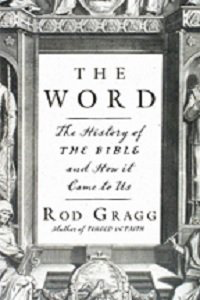By: WND – wnd.com – November 5, 2018
Recent polling data reports that a copy of the Bible can be found today in 90 percent of American homes. Although much has changed in the world around us, the Bible remains the most popular book in all the world.
“Throughout eons of human history, men and women have sought to live according to the Bible, and countless numbers have given their lives for it,” award-winning author and historian Rod Gragg observes. “Why has the Bible been so revered? How did it come to us? And why have billions of believers through the ages considered it to be inspired by God?”
These are a few of the questions explored in his latest book, “The Word: The History of The Bible and How it Came to Us.”
Here is a question and answer interview with Gragg:
Question: You’ve written many history books on a variety of topics. What let you to write a history of the Bible?
Gragg: Before being a historian, I’m a Christian, so I have deep respect and love for the Bible. As a historian. I always want to know the back-story, so to speak. So, it was my hope for a long time to be able to write a history of the Bible. It’s a fascinating story about the book of Books – the one book that that’s found in 90 percent of American households today.
Q: As is typical of your books, The Word has a lengthy bibliography and extensive source notes. However, you wrote the book for all readers, not just historians and Bible scholars, correct.
Gragg: Right – it’s based on sound scholarship, but it isn’t intended to be academic in style. It’s what’s called a “popular history,” meaning that it’s written for any and all readers. I like to think that I’m doing the research that the average person interested in the Bible would love to do if he or she had the time.
And it is an extraordinary history. When you hold the Bible in your hand today, it’s both inspiring and sobering to think about the countless people over the ages who have lived by its truths, and so many others who have died for it in order for us to have it. The history of the Bible is remarkable and inspirational.
Q: Among the many fascinating stories you share in this book, do you have a favorite? Did your research reveal anything that surprised you?
Gragg: Well, a lot impressed me deeply for sure. I think that some of the most memorable stories center around the early translators who risked so much to translate the Bible into English: Wycliffe, Tyndale, John Rogers and others.
I think about John Wycliffe, an elderly Bible scholar at the end of his days who translated the Bible into English because he wanted everyday people to have access to the Bible. This was before the Gutenberg movable type press, so His translation had to be hand-printed, and therefore, it was very expensive. Due to the costs, people tried to borrow or even rent a copy. It was said that the going rate to borrow a Wycliffe Bible was a full wagon-load of hay. Church authorities did not share that enthusiasm. After Wycliffe died, they had his body disinterred and burned, then his ashes were tossed in a nearby river. However, he had inspired the dream of a Bible in the English language.
Another favorite story of mine occurred much later in early Colonial America. It’s the story of the first Bible published in America, what became known as the “Eliot Indian Bible.” It was published in 1661 by John Eliot, who was a Puritan missionary to the Native American people of New England. He and a team of Indian consultants translated the Bible into the Wopanaak-Algonquin language, which not only opened the Scriptures to New England’s Native American people but also helped preserve their language.
Q: We hear about modern-day attacks on the Bible and Bible-readers around the world, but hasn’t that been going on since the beginning?
Gragg: That’s true – and attacks continue to arise in new places. The history of the Bible is filled with repeated attempts to suppress, eliminate or neutralize its message which is remarkable since the Bible is God’s love letter to humanity.
In fact, the book opens with an introduction that refers to King Josiah, who reigned over the southern kingdom of Judah in the 7th century B.C. and directed a Bible-based reform movement because his grandfather, King Manasseh, had attempted to replace the Bible with Baal worship. Attempts to suppress or destroy the Bible and persecute those who accept it as the Word of God have been a recurring phenomenon throughout history.
Q: What were some of the major attacks that the Bible has survived through the ages?
Gragg: The Word chronicles attempts to suppress, displace or destroy the Bible by first-century cults such as the Gnostics, waves of persecution under the Roman empire, barbarian raiders and invaders, the Communist governments of the Soviet Union and China among others in modern times. This includes Adolf Hitler’s Third Reich, which attempted to replace the German church with a Reich Church that would substitute the Nazi swastika for the cross.
All attacks on the Bible failed to eliminate it, of course. It’s been said that the Bible has outlived a lot of would-be undertakers. I think many Christians would see that as fulfillment of an observation in the Old Testament book of Isaiah: “The grass withers, the flower fades, but the word of our God stands forever.”
Q: How many ancient Bible manuscripts exist today? What are some of the most important ones?
Gragg: More than 5,000 partial or complete manuscripts from the New Testament alone exist today. What’s believed to be oldest existing New Testament fragment is Papyri 52 or P52, which is held by the John Rylands Library in Manchester, Britain. It’s from John 18, reporting the trial of Jesus, and it dates from A.D. 90-150. It shows the Gospel was recorded by the mid-second century A’D’ or even the late first century, which is historically close to the events reported in the New Testament.

The three most important and famous ancient Biblical manuscripts are Codex Sinaiticus, Codex Vaticanus and Codex Alexandrinus. Codex Sinaiticus, or most of it, is held by the British Library in London. It’s a translation of the Bible in Greek from more than 1,600 years ago, dating to about A.D. 340. It contains the oldest complete copy of the New Testament in existence, and about half the Old Testament. It was in the collection of St. Catherine’s Monastery on the Sinai Peninsula in Egypt until the mid-19th century, when it was acquired by the German Bible scholar Constantine Tischendorf.
Codex Vaticanus is just about as old – it dates to the first half of the fourth century A.D. It’s preserved in the Vatican, which acquired it about fifty years before Columbus landed in America. Codex Alexandrinus is also preserved in the British Museum. It dates to the fifth century – about A.D. 425 – and is believed to have been kept in an ancient church library in Alexandria, Egypt. The existence of these and other ancient biblical manuscripts demonstrates that the text of the Bible we read today has been faithfully transmitted from ages past to modern times.
Q: How has the age of Bible manuscripts been determined?
Gregg: One method is radiocarbon dating which is sometimes used to determine the age of an object from antiquity. However, much more about ancient literature has probably been determined from linguistics and paleographical analysis which is the study of handwriting and its tools. But that’s another book in itself.
Q: There’s a common belief in some circles that the books of the Bible were selected by church councils, which picked some and dropped others. Did your research support that view?
Gragg: The church councils did not pick the books of the Bible. The Old Testament canon was already well-established by the Jewish community more than 250 years before Christ. As for the New Testament canon, orthodox Bible scholars believe that it was not a group of books assembled by chance or forced on the early church by fourth century church councils but was steadily and unhurriedly established through its acceptance by church congregations from the first century onward. Accordingly, the church councils did not pick the 27 books of the New Testament, but rather acknowledged what already had been accepted by the Christian community.

Q: When did the Bible as we know it today become established or canonized?
Gragg: All the books of the Old Testament are generally believed to have been completed by the time of the Old Testament scribe and priest Ezra (about 445 B.C.) with the Old Testament canon established by the third century B.C. After Roman forces conquered Jerusalem and destroyed the temple in A.D. 70, a Jewish center of Biblical scholarship arose in Yavne or Jamina, west of Jerusalem. Jewish scholars there over time acknowledged the 39 books that Protestant churches accept today as the Old Testament to be the Hebrew Bible. But those books had long been recognized by the Jewish people as being divinely inspired and thus canonical, so it was a matter of acknowledging what already existed.
The New Testament canon is believed to have been developed by the mid-to-late second century – by then the early church fathers had quoted from all 27 books of today’s New Testament. It was established not by a single meeting or by a pronouncement by a group of Christian leaders, but by the progressive, unhurried acceptance of those 27 books by Christian congregations in the era of the early church. Historically, Christianity has attributed the emergence of the New Testament as an act of the Holy Spirit. By the time the famous church councils began meeting in the 4th century A.D., the New Testament canon was already well-established by the use of those 27 books within the early church. So, the councils did not actually pick books and declare them to be the Bible; instead, they recognized or acknowledged the canon that already existed.
To see this article, click read more.
Source: ‘The Word’: ‘History of the Bible and How it Came to Us’
 Listen Online
Listen Online Watch Online
Watch Online Find a Station in Your Area
Find a Station in Your Area








 Listen Now
Listen Now Watch Online
Watch Online
